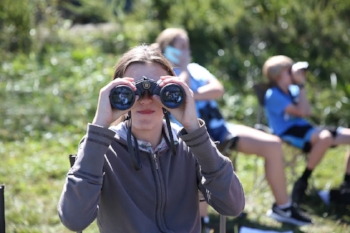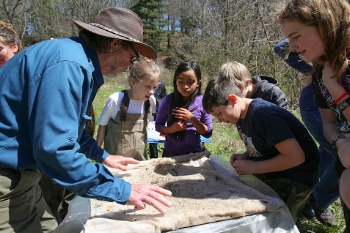

Mahogany Rock Hawk Watch
On September 23, thirty seventh graders from Grayson County Public Schools attended the Mahogany Rock Hawk Watch to experience the niche dedication of Hawk Counters and the mass migration of Broad-winged Hawks. Jim Keighton from the Blue Ridge Birders has been recording the migration of birds of prey for nearly twenty years! Each fall Jim sets up his swivel chair and interpretive displays along the parkway and begins scanning the sky. Not only does he diligently track the migration but he also takes the time to educate the passerby about the migration occurring overhead.

BRDC Partners with Grayson County Schools
We are pleased to announce our partnership with Grayson County Public Schools to connect local youth to the Blue Ridge through hands-on programs with students, providing grade specific SOL’s and STEM learning concepts. The $10,000 award from Grayson County Schools for the 2016-17 school year, supported by matching funds and volunteer support from BRDC, will reach students across the school system and enrich the public school experience through hands-on and interest-driven activities.

Students explore the life of birds through BRDC's Avian Adventures
On Monday afternoon William Roberts (board member of Blue Ridge Discovery Center and Scott Jackson-Ricketts (program director of BRDC) introduced the art of birding to Mark Robinson’s biology enrichment class. After sharing names and a getting-to-know-one-another session, we began by holding up bird flash cards to determine what birds, if any, the students recognized.

Wrapping up 2015 Bird Sleuth program at Grayson County High School
We had two working classes: Becky Absher’s ecology and Deb Greif’s/Kathy Davis' math analysis. Working with both classes from March through April, Blue Ridge Discovery Center focused on acquainting the students with local birds, their habitats and behavior. Starting in early March, we divided up our instruction time between in-class studies and outdoor walks behind the school. Through Cornell’s Lab of Ornithology curriculum, called Bird Sleuth, we watched a series of videos dedicated to the skills of bird id and natural history. Outside, along Stinky Creek, we set up a few bird feeders to draw in common feeder birds, giving us the opportunity to put our new-found skills to test.

Recent BRDC activities: Farm Days and the Carolina Raptor Center
On the 22nd and 23rd of May, busloads of grade-school kids flowed through a variety of activities at the Matthews Living History Farm Museum. They were treated to live music, story-telling, farm animals, historical farm equipment, a real vegetable garden and insect explorations. Blue Ridge Discovery Center provided kids with bug nets, capture boxes and magnifying lenses for closer viewing.

Bird Sleuth: Chapter 2
After weeks of often interrupted effort, snow, sleet and hail held off for Bird Sleuth's grand finale on Friday, March 21st. Bird Sleuth, an educational tool box designed by Cornell's Lab of Ornithology is a project managed under Avain Adventures, a BRDC program.

Bird Sleuth, chapter one
Bird Sleuth is a program designed by Cornell's Lab of Ornithology (http://www.birds.cornell.edu/Page.aspx?pid=1478). Blue Ridge Discovery Center decided to offer a first run of this investigative and hands-on citizen science project to two classes at Grayson County High School.

Hawk Watching with Galax High School
Mahogany Rock Hawk Watch with Galax HS Biology Students. On September 24th, BRDC hosted this year’s final Avian Adventures program at Mahogany Rock Overlook on the Blue Ridge Parkway. Teachers Emily Brown and Sam Starkey brought 12 kids for a day of hawk observations and discussions on migration.BRDC guides William Roberts and Scott Jackson-Ricketts began the program with a focus on a map, compass and questions about migratory patterns and the dynamics of energy saving flight techniques.

Joy Ranch field trip
Today, BRDC brought six young people, one mom and one staff member to the Music Center, and/or Fisher's Peak along the Blue Ridge Parkway for a walk in the park. Through our Avian Adventures Program we aimed to hear and find birds, who are winding down their typical territorial and breeding behavior, yet we managed to find indigo buntings, red-eyed vireo, field sparrows, a broad winged hawk and hooded warbler.

Birding at Grayson Highlands State Park
Birding with campers at Grayson Highlands State Park 6/29/13 Julie Slater, intern at GHSP, and Blue Ridge Discovery Center have joined forces for a series of on-site programs this summer and fall. (See previous blogs regarding the currency of this association through BRDC’s Fish Bugs program.) Our choice of study for this program was Sullivan Swamp (defined as an Appalachian shrub bog), with a strong focus on birds.

Birding at Joy Ranch
We began by listening and watching birds close to the chapel where we gave our orientation. Then, some of those who knew the campus, took us to a barn swallow nest.

Camp Dickenson
Through Eric Harrold's tireless outreach, BRDC is now engaged with the Methodist Camp Dickenson here in Grayson County with a series of summer programs focused on birds and ecology. Avian Adventures made its first foray last Thursday, June 13th, and along with guide Scott Jackson-Ricketts, Eric led a group of 13 kids for a walk around the riverside property.